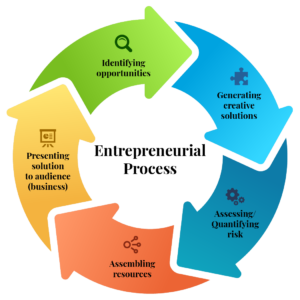Topic 1: Entrepreneurial Process
What is entrepreneurship? Numerous definitions exist regarding entrepreneurship, and the common default is, “Any attempt to create a new business.” However, this restricts entrepreneurial activities to just new or nascent organizations. Although entrepreneurship certainly has ties to the creation of new business entities, it is much more than that particular outcome. What about incumbent companies that already exist? Are they not able to be entrepreneurial? And what about small businesses that simply imitate or replicate what others are doing and don’t differentiate in any meaningful way? Would they be considered entrepreneurial?

Reflection Question: How do you define entrepreneurship? Write your answer in your Learning Journal.
In this course, the focus is on the entrepreneurial mindset, which can be applied to all kinds of situations and by all kinds of people. At its essence, the entrepreneurial mindset is about the art and craft of the creative, the unexpected, and the exceptional. It is about adding value by creating something and providing solutions that are better, faster, and/or cheaper than others. It is about continuous improvement and not being complacent. A critical aspect of the entrepreneurial mindset is learning from and managing mistakes.
Opportunity is defined as market failure or imperfect market conditions, meaning customers want something but they cannot get it. They have a problem but no effective solution exists, or a better solution is possible. Therefore, entrepreneurial action is needed to creatively solve those problems in a manner for which customers are willing to pay and will adopt. Entrepreneurs must manage and reduce the risk-reward equation (for customers and for themselves) and must then ACT with the tenacity to push an idea through to reality.
The working definition of entrepreneurship and the entrepreneurial mindset is as follows: Creative, value-added problem solving under conditions of extreme uncertainty and resource constraints.

The entrepreneurial process thus becomes a cycle of identifying opportunities or market failures (otherwise known as problems that need to be solved), using one’s skills, experience, and ingenuity for generating creative solutions based on those opportunities, assessing and quantifying the risk of those solutions (ideally minimizing that risk as much as possible), assembling resources (but expending as few as possible) to make the solution viable, and then presenting that solution to interested stakeholders, which can sometimes (but not always) culminate in the formation of a new business entity or unit.
This process is rarely linear, and entrepreneurs are often required to explore numerous opportunities, validate multiple potential solutions, minimize extremely risky and uncertain situations, overcome increased resource barriers, and convince various audiences before a truly viable entrepreneurial endeavor can be deemed successful. Entrepreneurs almost never get this correct on the first try, but those who are able to persevere and to overcome these challenges not only solve real problems for others but can find great personal satisfaction, which is often not the case of most other professional endeavors.
The application of this entrepreneurial process is not confined to just the creation of a new business but can be used to add value to existing organizations, social enterprises, family units, personal processes, and so forth. By enacting the entrepreneurial mindset and applying the entrepreneurial process to problems that exist around them, individuals and societies can create mutually beneficial relationships.

Reflection Question: Which part of the entrepreneurial process do you think is the most challenging? Which is the most intriguing? Write your answer in your Learning Journal.
Watch the video below:
 Seinfeld Sensei Application
Seinfeld Sensei Application
Problems often exist in people’s everyday lives that are just waiting for a new and creative solution. George and Kramer recognized just such an issue with George’s father, Frank, and demonstrated how the entrepreneurial process could be followed to pursue an idea.
Season 6, Episode 17 “The Doorman” (4:08)
Kramer’s identification of a potentially profitable entrepreneurial opportunity began with him recognizing a problem faced by an acquaintance. He then generated a possible solution by simply reapplying one that already existed to help with a problem commonly encountered by women, which opened up a potentially new set of customers. He asked questions of his target customer centered on the pains the customer was experiencing to learn more about the underlying problem. To further reduce the potential risk of his solution not being accepted by the market, he created a prototype to test out his idea with his target customer. Part of his resource assembly process included reaching out to potential partners to help with the manufacturing, branding, and distribution processes, and the positive feedback when presenting to an executive in the business helped demonstrate the immense promise of the entrepreneurial idea. Although not an ultimately successful idea, Kramer’s solution exemplified how the entrepreneurial process can be followed to help solve some of society’s “big” problems. This entrepreneurial process is explored in more detail throughout this book, with varying levels of success in the endeavors demonstrated by our Seinfeld case subjects.

